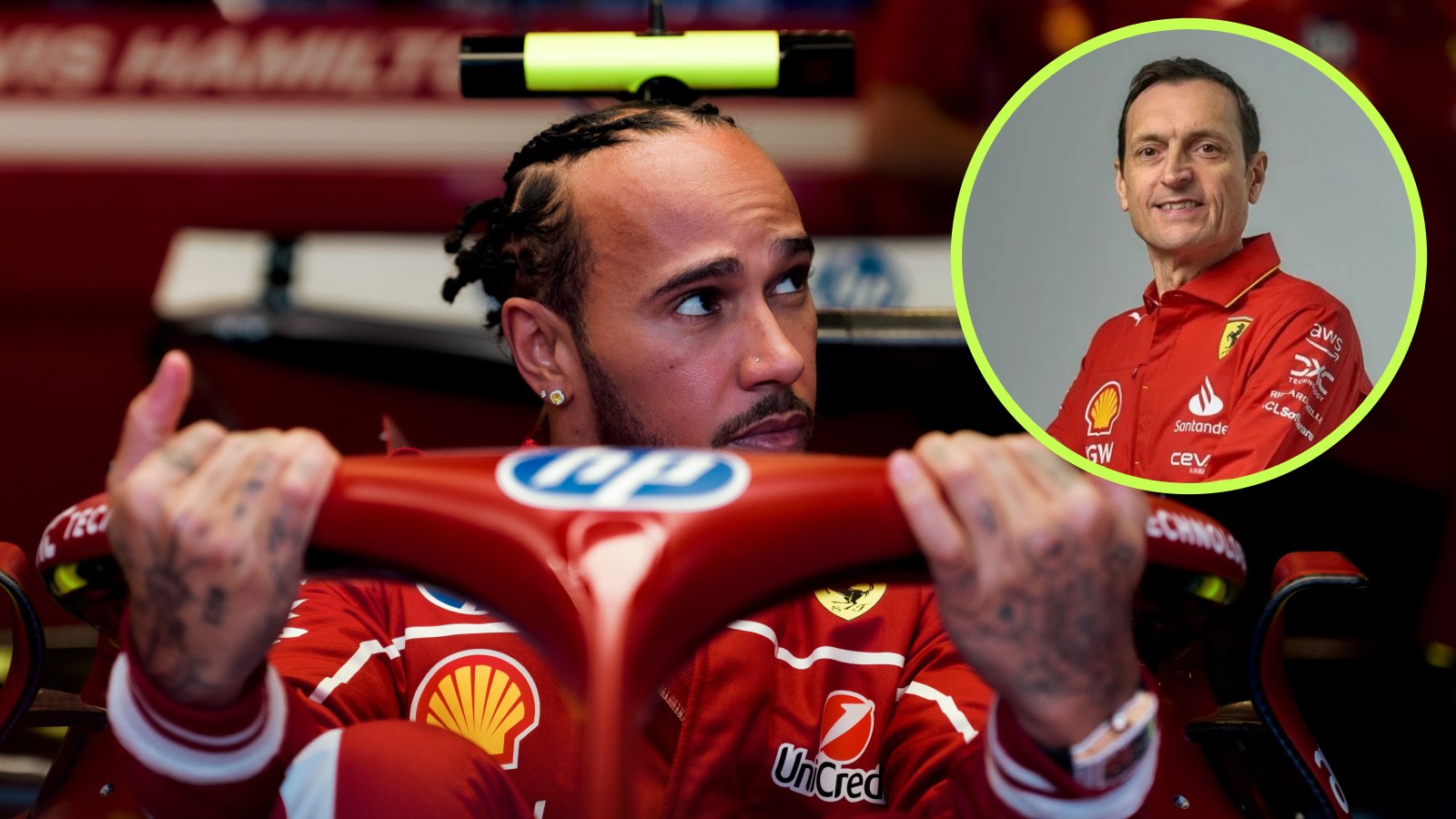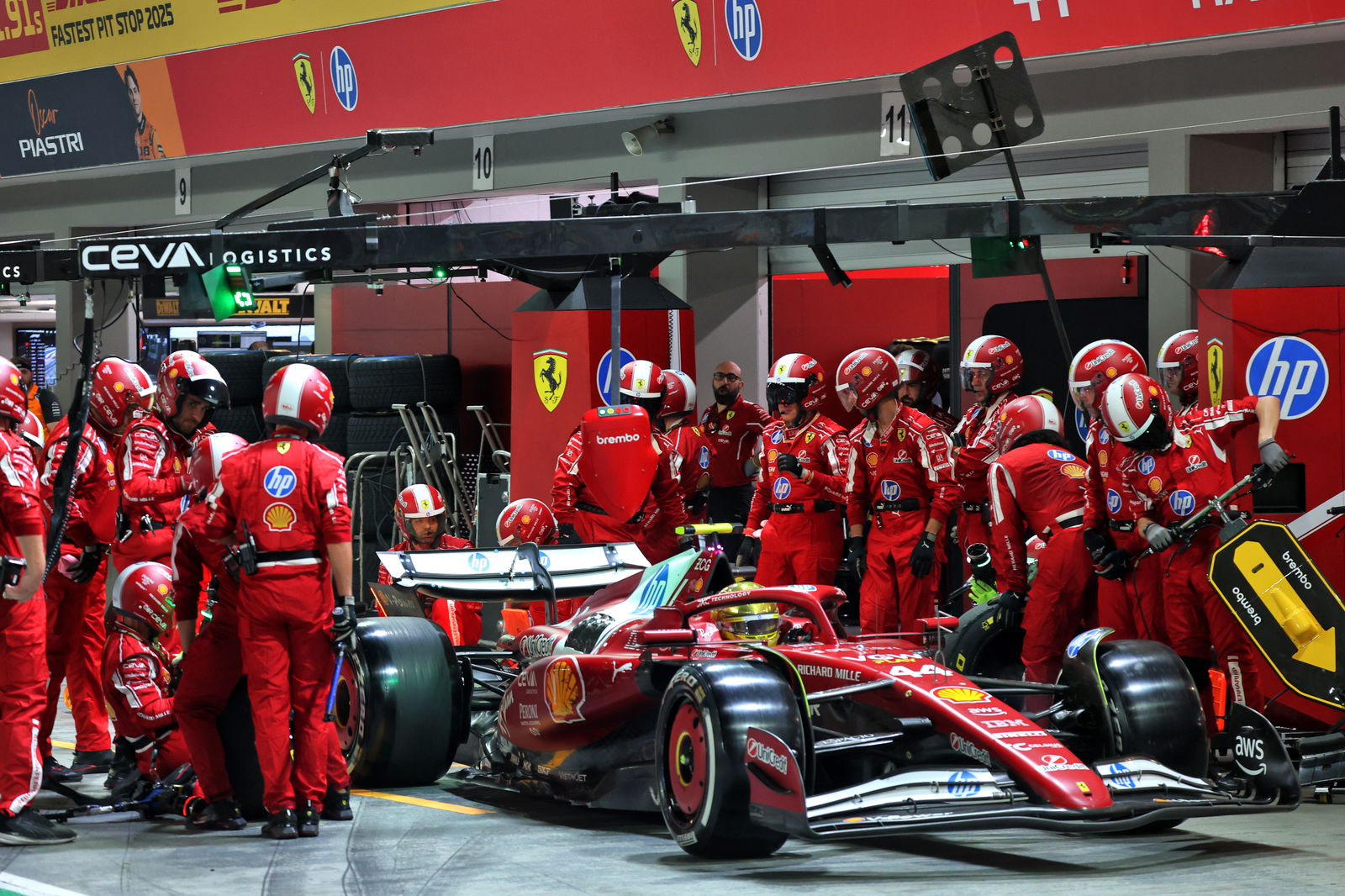The high-octane spectacle of the Singapore Grand Prix is famous for its demanding street circuit, where a single miscalculation can spell disaster. Yet, the 2025 iteration of the race transcended mere mechanical adversity and track limits; it became a raw, human drama broadcast across the airwaves.
A shocking, leaked team radio message has peeled back the curtain on the desperate struggle faced by Lewis Hamilton as his Ferrari’s front-left brakes failed dramatically in the closing laps, culminating in a controversial post-race penalty that demoted him and ignited the fury of an old rival.
What should have been a routine seventh-place finish quickly devolved into a crisis, showcasing a fragile equilibrium between driver survival, team strategy, and the unforgiving letter of the law. Hamilton, already battling a challenging weekend that saw him qualify a disappointing sixth, found himself fighting not just the competition, but his own compromised machinery.
The ensuing penalty, which knocked him down to eighth place, has sparked a lively debate across the F1 paddock: At what point does a technical failure grant a driver immunity from penalties for track excursions, and does the principle of force majeure still hold weight in the era of split-second scrutiny?

The Desperate Dance: When the Car Turns Against the Driver
The true severity of Hamilton’s predicament was laid bare in his frantic exchange with his race engineer, Ricardo Adami. As the final stages of the race unfolded, the seven-time World Champion, a veteran known for his precision and control, began visibly struggling to slow the Ferrari into the notoriously tight corners of the Marina Bay circuit. His onboard footage—and the immediate complaints of those behind him—revealed a clear, unnerving pattern: running deep into corners and increasingly taking to the runoff areas.
Hamilton’s response, when questioned by Adami, was swift, sharp, and laced with palpable stress: “I’m not trying to cut the course mate,” he retorted . The driver was wrestling with a machine that had fundamentally compromised its core function. His brakes were gone. The conversation painted a vivid picture of a world champion reduced to a desperate manager of a catastrophic failure, constantly seeking ways to compensate for a machine refusing to obey.
The issue was diagnosed as a critical failure of the front-left brake, leading to the driver repeatedly declaring over the radio: “Lost my brakes mate” . The team’s tactical response was to instruct him to employ “lift and coast,” an engine management technique designed to cool the brakes by lifting off the throttle early and coasting into the braking zone . While Adami understood the gravity of the situation, urging him to manage the issue, the damage was already done. Hamilton was running on borrowed time and compromised components. His attempt to hold position became a fight for survival, forcing him into aggressive, off-track shortcuts across turns 16 and 17 on the penultimate lap to keep the car from disaster.
The FIA’s Ruling: A Cold Refusal of Force Majeure
The incident immediately attracted the attention of the stewards, especially after the aggrieved Aston Martin team—and specifically Fernando Alonso—lodged a heated complaint. Hamilton managed to cross the line just four-tenths of a second ahead of Alonso, but the slender advantage was immediately nullified.
In the post-race hearing, Hamilton confirmed he had indeed left the track on several occasions, but cited his ongoing brake issue as the reason . He was hoping that the stewards would accept this as force majeure—an unavoidable, catastrophic technical failure that compelled him to deviate from the regulations to prevent a major incident. However, the FIA document, which ultimately levied the 5-second time penalty, was uncompromising.
“The stewards considered that this was not a justifiable reason and applied the usual penalty for such type of infringement,” the document read . This ruling sent shockwaves through the paddock, effectively establishing a precedent that a driver remains liable for track limits violations even when battling severe technical failures. The question is not whether the driver had a problem, but whether that problem was deemed severe enough to grant an exemption from the driving standards guidelines. The FIA’s verdict was clear: the onus was on the driver to manage the car—or retire it—within the rules, regardless of the mechanical handicap. The penalty dropped Hamilton from seventh to eighth in the final classification, a bitter pill to swallow for a driver who had just spent the final laps performing an emergency salvage operation.

Alonso’s Fury: Old Fires and Safety Debates
The driver who gained most from the penalty, and arguably the most vocal critic of Hamilton’s actions, was Fernando Alonso. The veteran Spaniard, known for his relentless pursuit of fairness and his long-standing, fiery rivalry with Hamilton, was incandescent over the team radio.
Furious over what he viewed as unfair racing, Alonso’s frustration was palpable and immediately broadcast to the world. He didn’t just complain about the track limits; he questioned the consistency of the stewarding and the fundamental safety standards being applied. He referenced a previous incident from the weekend where Hamilton had been cleared of a red flag violation during FP3, suggesting the officials were showing leniency .
“This should be P7. I mean, no respect for the red flag yesterday, today free track for them—maybe too much,” Alonso vented. The comments were laced with a pointed, personal judgment, a clear indication that the competitive tension between the two champions—one of F1’s great rivalries—was far from extinguished. When his engineer, Andrew Vizard, informed him that Hamilton had exceeded track limits more than four times, Alonso delivered his own blunt verdict: “5 seconds minimum,” he declared .
But Alonso’s critique went deeper than mere scoring points. He raised a serious question about safety, directly challenging the idea that Hamilton was allowed to continue with critically compromised brakes: “For me, you cannot drive when the car is not safe. You know sometimes they try to disqualify me with no mirror and now you have no brakes and everything is fine—I doubt it,” he argued . This stance forced the debate beyond a simple track limits infringement, framing it as a potential safety breach that warranted far stricter intervention than a mere time penalty.
The Emotional Breaking Point: “Just Leave Me To It, Mate”
The most poignant and revealing part of the leaked exchange was the emotional toll the crisis took on Hamilton. After enduring the constant, nagging advice and having to manage a catastrophic failure while simultaneously being chastised for cutting corners, Hamilton’s frustration reached a peak.
When cautioned for the final time not to cut the corners as Adami tracked Alonso closing rapidly—10 seconds behind, then five, then 2.5—Hamilton’s final, exhausted plea was a request for autonomy and peace: “Just leave me to it mate, leave me to it,” he snapped . This phrase encapsulated the immense pressure of the moment. It was a world champion, hyper-focused and operating in a state of high-alert, needing singular concentration to bring a fundamentally broken machine home, seeking an end to the distraction from the pit wall. It was the sound of a driver reaching his mental and technical limit.
Upon returning to the pits, the pessimism was confirmed. Adami informed Hamilton that a penalty was likely coming his way. Ever the eternal optimist, Hamilton held out a sliver of hope, still believing the sheer scale of the technical failure might exempt him: “Surely there’s no penalty when it’s force majeure?” he questioned . The eventual ruling confirmed his fear—in the eyes of the FIA, the technical failure was not sufficient to justify the deviation.

The Shadow of Strategy: Ferrari’s Systemic Pressures
The debacle was not just a driver-specific failure; it was another uncomfortable sign of the systemic pressures weighing down on the Ferrari team. Team Principal Fred Vasseur had to admit post-race that Hamilton’s entire Grand Prix was effectively compromised “from the very start” , confirming that a lingering brake issue had forced the ‘lift and coast’ strategy throughout the race.
Vasseur’s admission highlights the thin ice Ferrari has been operating on, often appearing to sacrifice true performance for reliability management. “It will be difficult to start with the positive, yes we were hitting not from lap one but from lap two or three and we had to do a lift and coast for the race,” he conceded . While he praised Hamilton’s pace during the few laps they were able to push, he acknowledged the impossible task of driving “95% of the race on the back foot” .
Adding further fuel to the fire, Sky Sports F1 pundit and former world champion Jenson Button offered a scathing assessment of the Scuderia’s current state. He suggested that the team’s struggles run deeper than mere on-track pace, pointing directly to the organizational culture. Button noted that the immense pressure on the team’s leadership often bleeds into their race strategy, resulting in decisions born out of desperation rather than confidence .
“You can’t be afraid to fail, and that’s what it feels like at Ferrari. I think everyone feels it’s easy to be pushed out the door, and it’s not a nice feeling to have,” Button commented . He stressed the necessity of consistency throughout the team to build confidence for everyone, including the drivers. This analysis suggests that Hamilton’s frantic radio plea and eventual penalized excursion were perhaps not isolated incidents, but symptoms of a high-pressure environment where every technical flaw and strategic error is magnified.
The Singapore Grand Prix will be remembered less for its winner and more for the dramatic exposure of Lewis Hamilton’s mid-race crisis. The leaked radio exchange gave fans a rare, raw glimpse into the cockpit during a moment of crisis, humanizing a sport often reduced to lap times and clinical strategy. The debate over the controversial 5-second penalty, the application of force majeure, and the fiery comments of Fernando Alonso ensures that this incident will remain a flashpoint in the discussion of fairness, safety, and the relentless pressure that defines life at the pinnacle of Formula 1. It serves as a stark reminder that even the greatest drivers are utterly dependent on their machine, and when that machine fails, the line between heroism and penalty becomes terrifyingly thin.